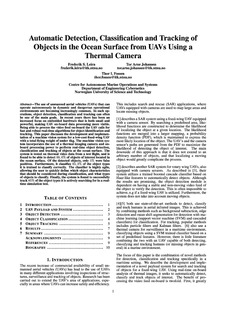Automatic detection, classification and tracking of objects in the ocean surface from UAVs using a thermal camera
Journal article, Peer reviewed
Accepted version
Permanent lenke
http://hdl.handle.net/11250/2496489Utgivelsesdato
2015Metadata
Vis full innførselSamlinger
Sammendrag
The use of unmanned aerial vehicles (UAVs) that can operate autonomously in dynamic and dangerous operational environments are becoming increasingly common. In such operations, object detection, classification and tracking can often be one of the main goals. In recent years there has been an increased focus on embedded hardware that is both small and powerful, making UAV on-board data processing more viable. Being able to process the video feed on-board the UAV calls for fast and robust real-time algorithms for object identification and tracking. This paper discusses the development and implementation of a machine vision system for a low-cost fixed-wing UAV with a total flying weight of less than 4kg. The machine vision system incorporates the use of a thermal imaging camera and on-board processing power to perform real-time object detection, classification and tracking of objects in the ocean surface. The system is tested on thermal video data from a test flight, and is found to be able to detect 99;6% of objects of interest located in the ocean surface. Of the detected objects, only 5% were false positives. Furthermore, it classifies 93; 3% of the object types it is trained to classify correctly. The classifier is highly agile, allowing the user to quickly define which object characteristics that should be considered during classification, and what types of objects to classify. Finally, the system is found to successfully track 85% of the object types it is actively searching for in a real-time simulation test.
